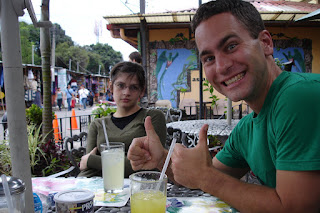I woke up at 4:30 this morning. I woke up at 4:15 yesterday. So did Jessica. It's the Virgen de Guadalupe festival here, and all over Mexico – while the Iglesia Real de Guadalupe (prominently featured in many pictures out our front windows) in San Cristóbal is among the more important such churches in Mexico, it is by no means the biggest and baddest (we've heard tell of pilgrims crawling on hands and knees for miles this week to beg miracles at the Iglesia de Guadalupe in Mexico City).
Thing about parties here is that everybody knows it's a party only because there are fireworks (small airborne bombs) exploding every 10-30 minutes, 21 hours a day. I mean, how else are you going to let everybody know? You can also manage that, at least in part, by posting a live band at the church, beginning each morning at 6, and playing until early afternoon, sure, but that's going to get you only so far. Better to be safe, and do both. And processions: hundreds (literally hundreds) of small processions of barefoot youths, bearing torches and drums, running through the streets in the pre-dawn hours, beating those drums and chanting (yelling), so to be heard up in heaven, as well as by those of us still in this earthly realm. Yes, now I know there's a party on. Oh, and yesterday everyone was painting mustaches on their infants.
 Where is the church? Is it foggy? No, that's just smoke from the cuetes.
Where is the church? Is it foggy? No, that's just smoke from the cuetes.If this 13-day party sounds like enough to send you on something of a tirade, let me share with you the experience of one of our American friends here, also suffering through his first festival de Guadalupe. Dan (our friend) was hanging out with his three Mexican roommates – all cool people, tolerant and relaxed – and he was venting a little of his frustration at the early city-wide wake-up calls and such, as follows:
"
Pinche antorchas (
fucking processions).
Pinche cuetes (
fireworks).
Pinche fiestas."
At this, the roommates are smiling and nodding in commiseration with their clearly frazzled friend.
"
Pinche puta de Guadalupe!" (pretty much:
Fucking whore of Guadalupe)
Suddenly the smiles are gone. No one is nodding. Dan notices the change, and looks around at his roommates in the thick silence. No one is looking at him. After a minute, the very kindest of the roommates, still looking away, tells him, "It's ok, because we're all friends here. But you won't say that again."
So don't get too worked up. More than the Virgin Mother, Guadalupe is probably the most salient, internally-appreciated symbol of Mexico and her people. Now and again, somebody notices some natural phenomenon that has taken the shape of the Virgin, and people come from all over to look on the
milagro, such as happened just a couple of years ago in Mexico City, when construction work in a subway station led to a water leak that created a peculiarly-shaped stain. Pilgrims came from all over the country to see this subway-station stain. Just to illustrate, this is serious business here.
Anyway, let's get on to some lighter fare. Ephraim was in town for almost 10 days, and my parents were here for Thanksgiving weekend, and a great time was had by all. Ephraim's trip began with a trip to Palenque and the Panchan. We were greeted there by a

troupe of howler monkeys, climbing and jumping and howling, all in plain sight, up in a big jungle tree. Thanksgiving was lots of fun, and some of our American friends here in S.C. came over for dinner, so it was a bit of a crowd. The next day we drove a couple of hours to see the ruin site of Toniná, which was awesome. Not as sprawling as Palenque, Toniná is a whole complex of temples and towers climbing up a hill, from which you can look out on a wide rolling charmingly cow-populated valley. We took a picnic.
Now we're by ourselves again, but not for long. It's back to Oregon in just one week, and we are getting a little excited. Not so much excited to leave (though leaving these early-moring
cuetes will be quite a thing), as excited to get back to people and places that we really like to see.
 our god-daughter, María de Jesús, and her cake (we didn't choose the blonde-haired Cinderella decoration)
our god-daughter, María de Jesús, and her cake (we didn't choose the blonde-haired Cinderella decoration)




















































